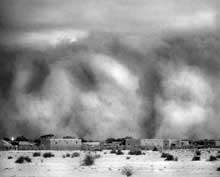Heat and dust
 desert dust blown from one part of the world to another can choke rain clouds, cutting rainfall hundreds of kilometres away. This discovery, made with the help of us National Aeronautical and Space Administration ( nasa) satellites, suggests that droughts over arid regions, such as central Africa, are made worse by damaging land and livestock-management methods that expand the desert.
desert dust blown from one part of the world to another can choke rain clouds, cutting rainfall hundreds of kilometres away. This discovery, made with the help of us National Aeronautical and Space Administration ( nasa) satellites, suggests that droughts over arid regions, such as central Africa, are made worse by damaging land and livestock-management methods that expand the desert.
The findings are reported in the Proceedings of the National Academy of Sciences. They present a new view of the decades-long drought in the African Sahel, which has been accompanied by increasing levels of airborne dust during the rainy season.
The higher dust frequency is not necessarily a result of the decreased rainfall, but rather its cause, according to scientists from Hebrew University and the Weizmann Institute, in Israel. "This impact of desert dust on rainfall was not known before,' says lead author Daniel Rosenfeld, Hebrew University, Jerusalem. "Due to the large sizes of some of these dust particles, it had been assumed that desert dust would increase rainfall rather than decrease it.'
Scientists had expected that the largest dust particles would form giant cloud condensation nuclei, which produce larger cloud droplets that speed the formation of rain. "Our laboratory analysis of the desert dust, however, showed that the particles contained very little water-absorbing matter,' said co-author Yinon Rudich, researcher at the Weizmann Institute, Rehovot. "As a result, even large dust particles form relatively small cloud droplets.'
The research shows dust amplifies the process of creating deserts. Activities that expose and alter the topsoil, such as grazing and agricultural cultivation, can increase the amount of dust blowing in the air. More dust reaching rain clouds produces less rainfall, which exacerbates the drought conditions and contributes to the desertification of the landscape.
Dust and other types of aerosol particles blowing into clouds act as nuclei around which water vapour can condense to form cloud droplets. If a lot of dust enters a cloud, the available water is spread over many small droplets. These small droplets grow more slowly through collisions with one another to the size of a raindrop, and the cloud yields less rainfall over the course of its lifetime. What the researchers saw in two separate cases, using different satellite observations, was that cloud droplets were smaller as dust concentrations increased.
nasa 's Tropical Rainfall Measuring Mission ( trmm ) spacecraft captured images of clouds over the Atlantic Ocean off the coast of northern Africa during a major dust storm last March. Droplet sizes steadily increased the farther the clouds were from dust-filled air. Rain was falling only from the dust-free clouds even though all the clouds contained equal amounts of water.
Related Content
- Air quality and climate bulletin 2023
- Final report by PPCB on management of scrap at Mandi Gobindgarh, district Fatehgarh Sahib, Punjab, 01/04/2021
- Dust storm wreaks havoc, claims two lives
- ‘Rajasthan storms trap Delhi-NCR in heat and dust, condition 'severe'
- Heat wave revives in Rajasthan, Phalodi, Bikaner hottest
- Declining pre-monsoon dust loading over South Asia: Signature of a changing regional climate
